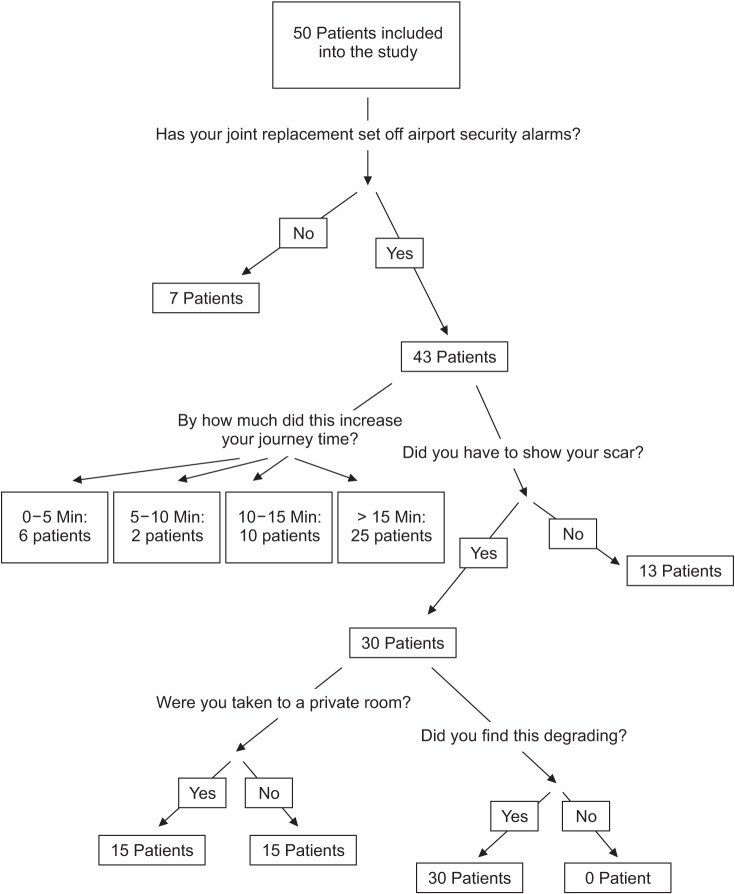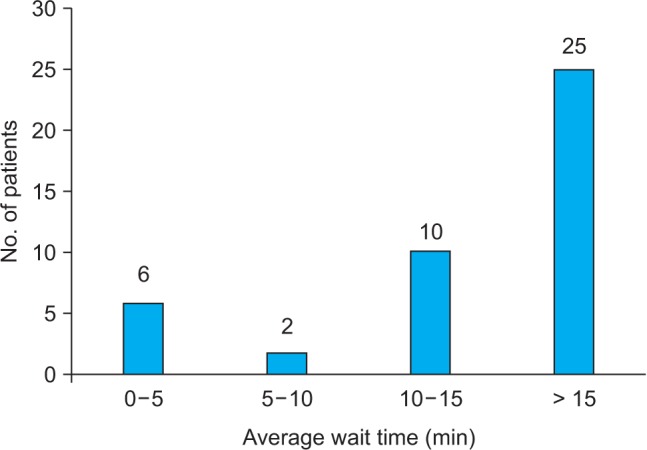Clin Orthop Surg.
2017 Jun;9(2):153-159. 10.4055/cios.2017.9.2.153.
The Need for an Implant Identification Card at Airport Security Check
- Affiliations
-
- 1Magdalene College, University of Cambridge, Cambridge, UK. erden@doctors.org.uk
- 2Department of Trauma and Orthopaedic Surgery, The Princess Alexandra Hospital NHS Trust, Harlow, UK.
- 3Department of Trauma and Orthopaedic Surgery, Broomfield Hospital, Mid Essex Hospital Services NHS Trust, Broomfield, UK.
- KMID: 2412282
- DOI: http://doi.org/10.4055/cios.2017.9.2.153
Abstract
- BACKGROUND
Joint replacement surgery is having an increasing demand as national healthcare systems confront an ever ageing population. Surgical complications associated with lower limb arthroplasty are well known but less investigation has been performed examining its effect on air travel, more specifically, unwanted and significant inconvenience caused to travelers going through airport security.
METHODS
In lower limb arthroplasty clinics, 50 patients who met our selection criteria were given questionnaires. Ten airport security officers from 4 international airports (London Stansted, London Gatwick, London Heathrow, and Amsterdam Schiphol International Airport) were also given a separate questionnaire. The opinion of the Civil Aviation Authority was also sought.
RESULTS
All 50 patients (mean age, 70.4 years; range, 55 to 84 years) who were presenting in lower limb arthroplasty clinics and who met our selection criteria volunteered to enter the study. Twenty-eight of these patients were female (mean age, 69.1 years; range, 55 to 84 years) and 22 were male (mean age, 71.2 years; range, 58 to 81 years). Of the patients, 14% stated that their joint replacements did not set off the airport security alarm. Responses were received from 10 airport security officers as well. Six airport security officers were male and 4 were female. All of the airport officers were aware of some form of implant identification card with 90% stating that these were useful to them at airport security. Eight-four percent of the patients stated that an implant identification card outlining what joint replacement they possessed and when this had been done would be very useful. Sixteen percent of the patients did not think a card would be beneficial since all of them had set off the airport alarm system only once or less in their lifetime.
CONCLUSIONS
It is the opinion of airport security officers and patients that joint replacement implant identification cards streamline airport security checks and decrease the need for more invasive searches at airport security.
MeSH Terms
Figure
Reference
-
1. Obremskey WT, Austin T, Crosby C, et al. Detection of orthopaedic implants by airport metal detectors. J Orthop Trauma. 2007; 21(2):129–132. PMID: 17304069.
Article2. Pearson WG, Matthews LS. Airport detection of modern orthopedic implant metals. Clin Orthop Relat Res. 1992; (280):261–262.
Article3. Lee AJ, Jacobson SH. Identifying changing aviation threat environments within an adaptive Homeland Security Advisory System. Risk Anal. 2012; 32(2):319–329. PMID: 21801188.
Article4. Abbassian A, Datla B, Brooks RA. Detection of orthopaedic implants by airport metal detectors. Ann R Coll Surg Engl. 2007; 89(3):285–287. PMID: 17394716.
Article5. Beaupre GS. Airport detection of modern orthopedic implant metals. Clin Orthop Relat Res. 1994; (303):291–292.
- Full Text Links
- Actions
-
Cited
- CITED
-
- Close
- Share
- Similar articles
-
- Information and Communication Technologies for Smart Airport
- Designing the Memory File System for Standardizing A Korean Medical Healthe IC Card
- Determinig the Access Limitation for Items in a Medical Health IC Card: Pursuing the safety and security
- The impact of modern airport security protocols on patients with total shoulder replacements
- Implementation of An Electronic Prescription Transfer System Using by IC Card



